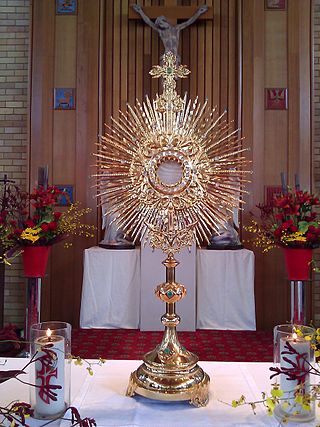
Hanceville is a city in Cullman County, Alabama, United States. At the 2020 census, the population was 3,217.

A monstrance, also known as an ostensorium, is a vessel used in Roman Catholic, Old Catholic, High Church Lutheran and Anglican churches for the display on an altar of some object of piety, such as the consecrated Eucharistic Sacramental bread (host) during Eucharistic adoration or during the Benediction of the Blessed Sacrament. A monstrance may also serve as a reliquary for the public display of relics of some saints. The word monstrance comes from the Latin word monstrare, while the word ostensorium comes from the Latin word ostendere. Either term, each expressing the concept of "showing", can refer to a vessel intended for the exposition of the Blessed Sacrament, but ostensorium has only this meaning.

The Eternal Word Television Network (EWTN) is an American basic cable television network which presents around-the-clock Catholic programming. It is the largest Catholic television network in America, and is purported to be "the world's largest religious media network", reaching 425 million people in 160 countries, with 11 networks.

Eucharistic adoration is a devotional practice primarily in Western Catholicism and Western Rite Orthodoxy, but also to a lesser extent in certain Lutheran and Anglican traditions, in which the Blessed Sacrament is adored by the faithful. This practice may occur either when the Eucharist is exposed, or when it is not publicly viewable because it is reserved in a place such as a tabernacle.

Mother Mary Angelica of the Annunciation, commonly known as Mother Angelica, was an American Roman Catholic nun of the Poor Clares of Perpetual Adoration. She was best known for the television show Mother Angelica Live. She was the founder of the international broadcast cable television network Eternal Word Television Network (EWTN) and the radio network WEWN. EWTN became a voice for Catholics worldwide.

Robert Joseph Fox was an American priest of the Roman Catholic church. He was an author of religious books and tapes, and appeared on many Roman Catholic television programs and conferences. Fox also served as a diocesan priest for several rural towns in South Dakota.
The Carmelite Sisters of the Most Sacred Heart of Los Angeles is a Catholic religious institute of the Carmelite Order founded by Mother Maria Luisa Josefa of the Most Blessed Sacrament. It is based in Alhambra, California, a suburb of Los Angeles.
The Dominican Nuns of the Perpetual Rosary are a religious institute founded in 1880 in Calais, France, by Father Damien-Marie Saintourens, Mother Rose of Saint Mary Werhle and Mother Mary Imelda Gauthier, all of them from the Order of the Preachers.
The Poor Clares of Perpetual Adoration (PCPA) are a branch of the Poor Clares, a cloistered, contemplative order of nuns in the Franciscan tradition. Founded in France in 1854 by Marie Claire Bouillevaux, the Poor Clares of Perpetual Adoration are cloistered nuns dedicated to the perpetual adoration of the Blessed Sacrament.

The Franciscan Missionaries of the Eternal Word is a Public Clerical Association of the Faithful, located in the Roman Catholic Diocese of Birmingham in Alabama. They were founded in 1987 by Mother Angelica, who also founded the Eternal Word Television Network (EWTN) and the Shrine of the Most Blessed Sacrament in Hanceville, Alabama.

The Basilica of the National Shrine of Mary, Queen of the Universe is a basilica located in Orlando, Florida at 8300 Vineland Avenue. It was built to service the large number of Catholic tourists who visit the attractions in the Greater Orlando area. While it is a 2,000-seat church of the Diocese of Orlando and provides Mass for the faithful, it has also become a regional tourist attraction. In 2009, it was designated as the 63rd minor basilica in the United States. Since it is not a parish church, only the Sacraments of Reconciliation and the Holy Eucharist are celebrated there.

The Divino Niño, also known as Divino Niño de Bogotá or Divine Child Jesus, is a 20th-century religious wooden statue of the child Jesus originating from Bogota, Colombia. A cross originally in the back was removed upon purchase by Father Giovanni Rizzo. The 17-centimeter high statue with arms stretched out wide and wearing a traditional pink robe or tunic has an inscription "Yo reinaré" at its base. It is one of the most popular religious images in Colombia, especially among Catholics and it is claimed to have miraculous powers of fertility and healing.

Rudolph William Steltemeier, Jr., known as Bill Steltemeier, was an American television executive, Roman Catholic deacon, and lawyer. Steltemeier served as the founding President of the Eternal Word Television Network (EWTN) from 1980 until 2000. He served as the CEO of EWTN from 2000 to 2009. Steltemeier remained the Chairman of the Eternal Word Television Network from 2000 until his death in February 2013.
Our Lady of Solitude Monastery is a Catholic foundation in the United States.

The Chapel of the Milk Grotto of Our Lady, also called Grotto of Our Lady or Milk Grotto, is a Catholic chapel in Bethlehem, in the West Bank, erected in 1872. Since Byzantine times, the place has been a center of Christian pilgrimage, maintained since its last erection together with its Marian shrine and monastery by the Custody of the Holy Land of the Order of the Friars Minor of the Catholic Church in Palestine. The Status Quo, a 250-year-old understanding between religious communities, applies to the site.
Benedictine Nuns of Perpetual Adoration of the Blessed Sacrament is a female enclosed Catholic order founded in Paris, France in 1653 by Mechtilde of the Blessed Sacrament.

The convent of Sacramentine or church of the Sacred Heart of Jesus is a religious building located in Vigevano, in the province of Pavia and diocese of Vigevano, Italy.



















